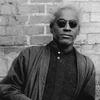More about Pray for America

Contributor
David Hammons’ Pray For America is a call to action that unfortunately still resonates today.
Created in 1969, it represents the failings of the United States government. Hammons made the piece just a year after the assassinations of Martin Luther King Jr. and Robert F. Kennedy, and when United States was in the middle of the Vietnam War. It was a very rocky time for our country, and for the world. But the image itself is only half the story. What really makes Pray For America so profound is the way that it was made.
Pray For America is a body print, which means Hammons would lather himself in substances like cooking fat or margarine and then smash his body against the canvas. When he was done, he’d sprinkle pigment onto the surface to give it a slight outline. The effect is an image of a ghostly body, almost skeletal like one would see in an X-ray. Then, to finish it off, he silk-screened the American flag over his imprint, the image acting like a veil or funeral shroud for the praying figure.
Because of the use of his body, Pray For America is performative in nature. Instead of painting a figure in a praying position, the figure we see on the canvas is, in essence, a remnant of Hammons himself. Art is always an extension of the artist, but this just feels like it goes deeper. And when you take into consideration the message of the painting, and the time that it was created, the fact that Hammons provided this part of himself furthers evocative power of the artwork. Pray for America calls for change in a time the country desperately needed it, and a Black man using his own body to call for that change is deeply meaningful when taken in the context of Black history in America.
Pray for America perfectly encapsulated the feeling of the time, yet the message remains relevant. Nearly 15 years after it was created, the work was featured as the promotional image for an exhibition at the Studio Museum Harlem. This was in 1985, and the prayer still resonated. As I’m writing this, it’s 2021, and the country is in the middle of a pandemic, countless natural disasters, and experiencing the same problems of racial inequity that pervades American history. Hammons has said that he is motivated by the "moral obligation as a black artist to try to graphically document what I feel socially," and the feelings of hope and despair demonstrated in this piece are still as relatable as ever.
Sources
- The Art Story. “David Hammons Artworks” Accessed February 20, 2021. https://www.theartstory.org/artist/hammons-david/
- Valentine, Victoria L. “Curator Laura Hoptman Reflects on Meeting David Hammons and Organizing Her New Show, the First Museum Exhibition Dedicated to His Body Prints” Culture Hype. February 17, 2021. https://www.culturetype.com/2021/02/17/curator-laura-h
- Jambhekar, Neha. “Editors’ Picks: 16 Events for Your Art Calendar This Week, From David Hammons at the Drawing Center to Duke Riley on the Great Molasses Flood” Artnet News. February 1, 2021. https://news.artnet.com/art-world/editors-picks-february-1-202











